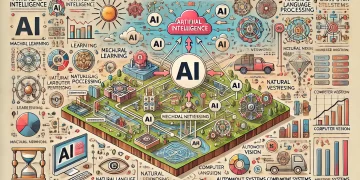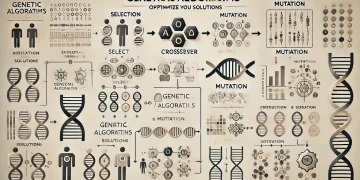In recent years, Artificial Intelligence has revolutionized the way we live, work, and interact. From personalized shopping recommendations and voice assistants to facial recognition and automated customer service, AI is becoming a natural part of our daily lives. However, as AI grows more sophisticated and pervasive, it raises a crucial question: How much of our privacy are we giving up?
The Rise of AI and Data Collection
AI systems rely heavily on data to function effectively. Machine learning models are trained on vast amounts of data that sometimes include personal information, online behavior, social media activity, location history, and even biometric data like facial features and fingerprints. This data fuels AI’s ability to predict, recommend, and automate.
For example, recommendation engines on platforms analyze your viewing and listening habits to suggest content you might enjoy. Similarly, smart home devices listen for voice commands to improve their responsiveness, which has raised concerns about whether they are always listening. More importantly, the sheer volume and sensitivity of the data being collected present significant privacy concerns.
Key Privacy Risks Associated with AI
1. Surveillance and Facial Recognition
AI-driven facial recognition technology is increasingly used by governments, law enforcement, and private companies. While it can improve security and streamline identification processes, it also enables mass surveillance, raising serious concerns about privacy and individual freedoms on a global scale. In some cases, individuals have been tracked without their knowledge or consent.
2. Data Breaches and Unauthorized Access
AI systems store and process large datasets, making them attractive targets for hackers. A breach involving AI-managed data could expose sensitive personal information, including financial details, medical records, and private communications. Recent breaches of major social media platforms have exposed millions of user profiles, highlighting the vulnerability of AI-managed data.
3. Digital Identity Theft
AI systems are increasingly used for identity verification, from facial recognition and fingerprint scans to AI-driven banking and financial services. However, this also makes personal data vulnerable to sophisticated attacks.
Hackers can exploit AI vulnerabilities to steal personal information, including login credentials, financial details, and biometric data. Deepfake technology, powered by AI, has made it easier for criminals to impersonate individuals, bypass security systems, and commit fraud. For example, AI-generated deepfake videos and voice cloning have been used to trick financial institutions and social media platforms, leading to significant financial and reputational damage.
Moreover, once personal data is compromised, it can be sold on the dark web or used for ongoing identity fraud, making recovery difficult. This raises the stakes for stronger security measures and more resilient AI-driven authentication systems.
4. Informed Consent and Data Misuse
Many AI applications collect data without explicit user consent or in ways that are not fully transparent. Companies often hide consent agreements in lengthy terms of service, making it difficult for users to understand how their data is being used. AI-driven targeted advertising is a prime example, where user behavior is analyzed and monetized without clear user understanding.
5. Bias and Discrimination
AI models can unintentionally reinforce existing biases in data. AI systems learn from the data they’re trained on, and if that data reflects existing societal biases or lacks diversity, the results can reflect those biases, even though the engineers themselves may not intend for that to happen. This can lead to discriminatory outcomes, for example, in hiring decisions, credit approvals, or law enforcement practices. Research has shown that biases in data can affect the accuracy of AI systems, particularly in areas like facial recognition, where misidentifications may occur more frequently for certain demographic groups.
6. Lack of Regulation and Accountability
AI development is moving faster than regulators can keep up. This regulatory gap allows companies to operate AI systems with minimal oversight, increasing the risk of privacy violations. When AI systems fail or misuse data, it’s often unclear who should be held accountable: the developer, the company, or the algorithm itself.
For example, imagine a voice assistant that accidentally records private conversations without the user’s knowledge. If this data is later exposed in a data breach, it becomes difficult to pinpoint who is responsible. Is it the company that created the voice assistant? The developers who programmed it? Or the algorithm itself that misinterpreted the user’s command? This confusion over accountability can make it harder to protect users’ privacy and enforce the necessary rules to prevent misuse.
Balancing Innovation with Privacy
The challenge lies in harnessing the benefits of AI while protecting individual privacy. Governments, businesses, and individuals can work toward this balance:
• Stronger Data Protection and AI Regulations: In addition to the General Data Protection Regulation (GDPR), the European Union has introduced the Artificial Intelligence Act (AI Act), which provides a comprehensive regulatory framework for AI systems across various sectors. The AI Act aims to ensure that AI technologies are developed and used in ways that are safe, ethical, and respect individual rights. It classifies AI applications into three risk categories (unacceptable, high, and limited) and imposes stricter obligations for high-risk AI systems, including:
- Risk Management and Mitigation: High-risk AI systems must undergo risk assessments and implement measures to mitigate identified risks.
- Transparency Requirements: AI systems must provide clear, understandable information to users, especially in high-risk areas like biometric identification.
- Human Oversight: AI systems must have mechanisms for human intervention when necessary, particularly when decisions have significant impacts on individuals.
- Accountability: Providers of high-risk AI systems must ensure their systems are traceable, auditable, and that any decisions made by the AI can be explained.
- Data Governance and Quality: AI systems must be trained on high-quality, diverse datasets to minimize bias and ensure fairness in outcomes.
• Ethical AI Development: AI developers should adopt “privacy-by-design” principles, embedding privacy protections into AI systems from the ground up.
• User Empowerment: Users should have the right to know what data is being collected and how it’s being used. Companies should offer clear, accessible options for opting out of data collection and processing.
• Accountability and Oversight: Establishing independent oversight bodies to monitor AI development and use can help ensure compliance with privacy standards and prevent misuse.
AI holds tremendous promises for improving our lives, but without adequate privacy protections, the risks could outweigh the benefits. By proactively addressing privacy risks and establishing strong safeguards, we can unlock AI’s full potential while preserving our fundamental rights. It is crucial that governments, businesses, and individuals collaborate to create transparent, ethical frameworks that ensure AI is developed and deployed responsibly. Only then can we fully harness the benefits of AI technology without compromising personal freedoms or societal values.






























